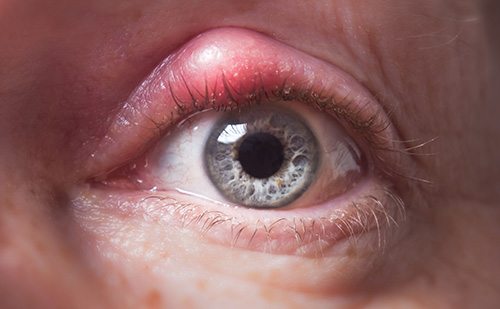Blepharitis
 Blepharitis is an inflammation of the eyelids that can affect people of all ages. Although blepharitis is an uncomfortable and frustrating eye disease, it is not contagious and usually does not cause any serious harm to eyesight.
Blepharitis is an inflammation of the eyelids that can affect people of all ages. Although blepharitis is an uncomfortable and frustrating eye disease, it is not contagious and usually does not cause any serious harm to eyesight.
Symptoms of blepharitis include eye irritation, flaking, burning, crusting, itching, redness in the eyelid margins, and a foreign body sensation. Greasy “scales” often form around the base of your eyelashes.
Types and Causes of Blepharitis
There are two main types of blepharitis:
- Anterior blepharitis – Occurs at the outside front edge of your eyelid, where the eyelashes are attached. This form of blepharitis can be caused by a wide range of factors, but in most cases, it is the result of bacteria (staphylococcal blepharitis) or dandruff from your scalp and eyebrows (seborrheic blepharitis). It can also be caused by Demodex, which is a mite that requires treatment.
- Posterior blepharitis – Occurs at the inner edge of the eyelid, where the lid makes contact with your eyeball. Posterior blepharitis often develops as a result of irregular oil production by your eyelid glands (meibomian blepharitis), which creates an environment that promotes bacteria growth. However, it can also be caused by other skin conditions, such as acne, rosacea, and scalp dandruff.
Some people only experience minor itching and irritation from blepharitis, but others may suffer from more severe symptoms, such as blurred vision and inflammation of the cornea.
Treatment for Blepharitis
If you are diagnosed with blepharitis, your treatment will depend on the specific type of blepharitis you have, and the severity of your condition. To start with, your doctor may recommend an ongoing eyelid hygiene regimen, including lid scrubs and warm compresses or a Meibomian Gland Treatment. If your blepharitis is bacterial, antibiotics will likely be prescribed.
More severe cases of blepharitis may require other approaches to treatment, such as topical and oral medicines. Nutritional supplementation can also help some cases of posterior blepharitis. Your doctor will develop an effective blepharitis treatment plan based on the circumstances of your specific condition.
If you have further questions about blepharitis, please contact Brooks Eye Associates or call 972-403-1110 to schedule an appointment. We serve patients in North Texas, including Plano, Frisco, McKinney, and Dallas.

Blepharitis is an inflammation of the eyelids that can affect people of all ages. Although blepharitis is an uncomfortable and frustrating eye disease, it is not contagious and usually does not cause any serious harm to eyesight.
Symptoms of blepharitis include eye irritation, flaking, burning, crusting, itching, redness in the eyelid margins, and a foreign body sensation. Greasy “scales” often form around the base of your eyelashes.
Types and Causes of Blepharitis
There are two main types of blepharitis:
- Anterior blepharitis – Occurs at the outside front edge of your eyelid, where the eyelashes are attached. This form of blepharitis can be caused by a wide range of factors, but in most cases, it is the result of bacteria (staphylococcal blepharitis) or dandruff from your scalp and eyebrows (seborrheic blepharitis). It can also be caused by Demodex, which is a mite that requires treatment.
- Posterior blepharitis – Occurs at the inner edge of the eyelid, where the lid makes contact with your eyeball. Posterior blepharitis often develops as a result of irregular oil production by your eyelid glands (meibomian blepharitis), which creates an environment that promotes bacteria growth. However, it can also be caused by other skin conditions, such as acne, rosacea, and scalp dandruff.
Some people only experience minor itching and irritation from blepharitis, but others may suffer from more severe symptoms, such as blurred vision and inflammation of the cornea.
Treatment for Blepharitis
If you are diagnosed with blepharitis, your treatment will depend on the specific type of blepharitis you have, and the severity of your condition. To start with, your doctor may recommend an ongoing eyelid hygiene regimen, including lid scrubs and warm compresses or a Meibomian Gland Treatment. If your blepharitis is bacterial, antibiotics will likely be prescribed.
More severe cases of blepharitis may require other approaches to treatment, such as topical and oral medicines. Nutritional supplementation can also help some cases of posterior blepharitis. Your doctor will develop an effective blepharitis treatment plan based on the circumstances of your specific condition.
If you have further questions about blepharitis, please contact Brooks Eye Associates or call 972-403-1110 to schedule an appointment. We serve patients in North Texas, including Plano, Frisco, McKinney, and Dallas.




